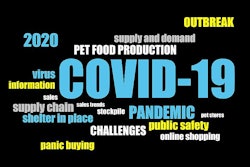
Many people do not understand the true nuances of pet food ingredient naming and definitions set forth in the Association of American Feed Control Officials (AAFCO) Official Publication, nor their gaps, which can be fully exploited by pet food companies. The only people knowing the actual ingredient going into the food is the supplier of the ingredient and the manufacturer of the food (in theory). For example, many are unaware that there are different grades of meat or poultry meal based on ash (i.e. bone) content; however, both would be labeled accordingly as meals.
Knowing the nuances in ingredient definitions
For the most part, AAFCO has straightforward ingredient naming and definitions. For example, when looking at poultry (chicken, turkey, duck, etc.), AAFCO identifies clear, concise naming and definitions for the different parts of an animal resulting from slaughter. Simply, this naming system is based on what is included and excluded from the definition to qualify for the ingredient naming. For example, per the naming and definitions below, one would not expect viscera to be included in chicken or chicken meal.
- Poultry (e.g., chicken) (9.57): clean combination of flesh & skin ….
- Poultry meal (e.g., chicken meal) (9.71): dry rendered product from the combination of clean flesh and skin ….
- Poultry by-products (9.14): consists of non-rendered clean parts of poultry including heads, feet, viscera and whole carcasses ….
- Poultry by-product meal (9.10): consists of the ground, rendered clean parts of poultry, such as necks, feet, undeveloped eggs, viscera and whole carcasses ….
It may taste like chicken – but it’s not!
Thus, the naming and definitions for poultry are clear, concise and straightforward. Unfortunately, this is not the case with definitions for mammal species (e.g., beef, bison, lamb, venison, etc.), which leave a lot of room for interpretation and variation. An example is where “flesh and skin” material is not specified in all meat definitions; you only see that in the poultry definitions. In fact, the meat meal definition is extremely broad, vague and allows for “rendered tissues.” Even more troublesome, it looks identical to animal by-product meal! Makes you wonder why AAFCO did not follow the same ingredient naming and definition scheme as for poultry, doesn’t it?
- Meat (9.2): is the clean flesh derived from slaughtered mammals ….
- Meat meal (9.40): is the rendered product from mammal tissues, exclusive of any added blood, hair, hoof, horn, hide trimmings, stomach and rumen contents except in such amounts that may occur unavoidably in good processing practices ….
- Animal by-product meal (9.42): is the rendered product from animal tissues, exclusive of any added hair, horn, hide trimmings, manure, stomach and rumen contents, except in such amounts that may occur unavoidably in good processing practices ….
- Meat by-products (9.3): is the non-rendered, clean parts, other than the meat derived from slaughtered mammals. It includes and is not limited to, lungs, spleen, kidneys, brains, livers, blood, bone, partially defatted low temperature fatty tissue, and stomachs and intestines freed of their contents ….
A journey back in time: biology 101
Cells make up tissues, tissues make up organs, organs make up organ systems, all of which ultimately make up our entire body system. Where am I going with this?
Well, it just so happens that AAFCO has its own definition for animal body tissues; they are called viscera. Viscera are defined as: “all organs in the great cavity of the body; it includes the esophagus, heart, liver, spleen, stomach and intestines but excludes the contents of the intestinal tract.” Wait a second, aren’t these the very items we have been told are “by-products” that we should avoid? At least, that is what marketing says!
Ingredient naming exploitation
At this point you probably know where I am going with this or may even feel duped. Based on the poultry definitions above, one could be led to believe meat meal contains only the dry rendered “flesh and skin” from mammals, when in fact you are likely feeding “flesh, skin and viscera” meal. Don’t believe me? Reread the definitions of meat, meat meal, animal by-product meal and meat by-products above. Can you tell the difference between meat meal and animal by-product meal?
Better yet, can you find a pet food in the marketplace that contains lamb by-product meal or bison by-product meal? Typically, you will only find poultry by-product meals (e.g., chicken and turkey) because those definitions are “goof proof” and do not have room for interpretation. Guess what? Same with fish!
Fun with math
The other part of the AAFCO meat meal definition states: The calcium level shall not exceed the actual level of phosphorus by more than 2.2 times.
Seems rather benign, right? Not really, since ash (i.e. bone content) of meat meal can be 20% or higher depending on the animal source, and the protein content may range from 50 to 60% because of ingredient and supplier variation.
AAFCO further defines meat meal: It shall not contain more than 12% pepsin indigestible residue and not more than 9% of the crude protein in the product shall be pepsin indigestible.
In layman terms, AAFCO attempts to define the quality of protein source by making sure digestible protein is > 88% via in vitro analysis. This is assuming the supplier and the manufacturer are performing the analysis on all receivable shipments, and unfortunately, most do not.
Now, imagine a pet food that has multiple high-ash meat meals with 12% of the protein being “indigestible.” When those meat meals are combined and then go through another round of high heat processing via extrusion, they are further damaged and/or denatured, making them less bioavailable (i.e. Mallaird reactions). Now you see why I often say knowing actual digestibility of the foods is critical in assessing the quality of foods, and it’s not just the nutrient content that should be analyzed.
False assumptions lead to inaccurate conclusions
Many of you are likely wondering why I shed some light on this topic. It is quite simple: If no one knows if you are using by-products or knows the quality of the meals you are using in the foods, then people will make false assumptions (and practice misleading marketing). False assumptions lead to inaccurate conclusions – much like the Food and Drug Administration’s Center for Veterinary Medicine (CVM) did in their recent update at the Scientific Forum Exploring Causes of DCM in Dogs.
In their recent (albeit quiet) update, CVM stated on slide 24 that there were zero cases with diets that contained meat/poultry by-products. This is inaccurate, since on the next slide they reported cases associated with lamb meal, kangaroo meal, pork meal, beef meal and bison meal – oops! Maybe someone ought to share with them the AAFCO definitions and nuances in ingredient naming and definitions?
If you do an investigation on the inclusion, or lack thereof, of an ingredient, then it becomes important to know what the ingredient is and is not. Don’t you agree?


















